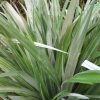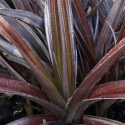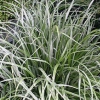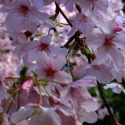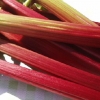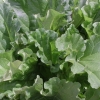img::focus:after{content:attr(title)}
Hi
Is it Possums, Peacockes, Pukes or Rabbits?
Harry was going on about the
Sally Holmes roses that we had planted as a hedge in our garden. One side was in full leaf flush and the other side was looking well... somewhat short on foliage. 'You have forgotten to
feed that other side" he goes.... but I was sure that they had been fed at planting time and again at bud burst!
I just happened to be out in the garden yesterday and had a look at them and sure enough the foliage was missing from around 25 new rose bushes. I can say that it wasn't because of lack of food, rather some two or four legged animal that just loves the new leaves on roses. At this point I'm thinking rabbits or possums but I haven't quite worked out which but I'm tending towards possums as there isn't any rabbit sh...t or digging that I can see.
Maybe its both! I was spraying the garden centre roses last night (there had been no rain for the day and it was going to stay dry) and noticed that a couple of the six foot standards weren't advanced as the others. No surprise here but again the new foliage had been eaten and I'm guessing that the possum was in the flowering cherry tree and hung right out on the branch till it dropped enough that it could eat the foliage on a
six foot standard. Rose leaves to possums must be like asparagus is to my taste buds, just delicious, but the problem is not just our rose bushes.
Needless to say some traps have been set, with some very tasty citrus as bait, which I'm hoping might appeal for dessert or is it the other way around.
Possums, rabbits or Pukeko's and in our particular location there are also wild peacocks by the hundreds that are causing me some grief that keep sneaking into my section. I hear you say how beautiful they are but a muster of peacocks leaving their rather large calling cards on our paved area is more than we want to keep washing off.
It never ceases to amaze me how the metal disappears
Despite the weather the nursery
car park and nearly all of the paths have had somewhat of a makeover with four truck loads of new metal and a day spent with a very clever man and his bobcat. It turned out to be a good job to do after some recent rain as the puddles outlined all the low lying areas that needed more metal.
The bob cat was the perfect size to get down the main aisles to dress them all with fresh metal and one that came up best was the main aisle down towards Pete's cottage underneath our aisle of
Prunus Awanui. Click
here to see the pics on our
facebook page.
Astelias are pretty cool foliage plants but you have to know a bit about them to grow them well in your garden. Now I find this pretty interesting but some
Astelias love to grow in the crutches of trees and often when you are in the bush or looking at the Pohutakawas at the beach you'll see these flax (for want of a better description) like plants high up in the tree. Once you know this you'll understand that they have a requirement for perfect drainage because not much water hangs around in a branch fork. The food that they will live on will be dertitus from the leaves that collect in the crutches of the trees. So really sharp drainage and they like organic matter but not around themselves, they cope with being dry and like dappled light to full sun.
Astelia Banksii has narrow silver green leaves
Astelia Frosted bronze, a stunning native that hails from the Chatham Islands. Strong broad swords of arching foliage coloured rich streaky bronze.
Astelia Rebel Do you want an easy care, tolerant plant that is architecturally interesting? If so then this is the plant for you. Narrow striking red green leaves that arch attractively. Tolerant of drought and poor soils. Perfect for group planting, or if you prefer, will do very well in a container.
Astelia Red Devil Distinctive, almost metallic silvery-red sword-shaped leaves. Strong structural form and a valuable addition to any garden. Superb stand-out feature plant, giving added texture and contrast in the garden or pots.
Astelia Silver spear A stunning native cultivar that originates from the Chatham Islands. Strong broad swords of arching foliage toned a sensuous metallic silver. Use in groups for a bold dramatic statement. Tolerant of sun or part shade but hates "wet feet". Looks fabulous in a container. Hardy and evergreen
Astelia Westland .A fabulous foliage plant ideal for group planting. Silvery, strap like foliage that is attractively flushed with red and bronze tones. The red colour intensifies in cold weather.
Something a tad different for a climber
I brought in some of these now that the winter has past. They can be a tad frost tender but once you have it growing up a wall I imagine that they will be quite tolerant, though may lose a few leaves.
Petrea volubilis, queens wreath or sandpaper vine.... Sandpaper vine because the leaves are quite firm and rough and not surprisingly like sandpaper and of a pleasing green, though often with a purplish tone. This plant make for an attractive climber but the blooms are its claim to fame with pretty purple sprays that consist of many individual flowers.
Don't forget about your lawn!!!
Spring is the time to feed lawns and the trick is to apply
Lawn fertilser when its going to rain. So far this month that could be any time lol, but seriously its one of those tasks that you want the fert to be rained or watered in so that it doesn't burn your lawn. These types are a quick fix and instant food like all the sugar that I have in my cups of tea!
Bioboost is an organic style food that has a perfect prill formulation for lawns as well meaning that it can pass through one of those fertilser spreaders. Organic foods provide much slower acting and longer term nutrients for your lawn but a program that incorporates both would be good.
Now if you have a fine lawn then its also a good time to spray out the broad leaves like clover, hydrocotyle, creeping oxalis, plantains dandelions. onehunga weed and the like.
Lawn spray,
Turfix,
prickle weed and
Hydrocotyle spray are all good ones to use as per the directions but do be careful with these sprays as anything that isn't a grass is a broad leaf. I always suggest that lawn spraying is one of those tasks best done early in the morn before the sun gets up and there isn't any wind drift as lawn type sprays do carry. Roses are particularly sensitive and I note that the Magnolia family also seem to exhibit lawn spray symptoms. Lawn sprays tend to work by causing excessive cell division at the growing points which is why you see a curling leaf sypmtom on the weeds that you spray and all other broad leaves behave the same.
The other point to note about lawn sprays is that they do have some residual effects so dont use the clippings from a sprayed lawn in your compost!!!!
Just in yesterday Red stemmed Rhubarb... These are all new clones and claim to fame are the beautiful red stems that will give your usual Rhubarb dishes that delightful red colour. I have one of these new red ones in my office potage garden and the red stems are really attractive even just as a garden plant.
Claret cobbler, This is a lovely vigorous variety that will keep providing you with gorgeous bright red stems for cooking all year round. Grown commercially for it's large red stems and it's ability to multiply quickly. Evergreen.
Crimson crumble A gorgeous new stunning bright, almost luminous red stemmed variety, This variety is slighlty bigger, evergreen with their stems staying red when cooked. Will look great in any crumble, pie, sauce or cullinary favourite you prefer.
Ruby tart... Red chard with brilliant crimson stems and veins contrasting bright green leaves. This strain, has been selected for savoyed leaves and bright, contrasting colors, even as the plants mature. Ruddy fool. Another gorgeous new stunningly red stemmed variety that colours up right from the start. Medium sized and compact reduces wind damage. The stems maintain their redness when cooked. Will look great in any crumble, pie, sauce or cullinary favourite you prefer. Cold tolerant, stems will grow redder in winter.
lets not forget about some of the classic varieties that have been around for years like
Glaskins perpetual This heritage Rhubarb hails from Brighton in the UK and is valued for excellent quality, slender bright red stalks and early maturing habit. Plant in humus rich soil that does not completely dry out in summer. Feed regularly with organic matter. Do not eat the leaves or feed to stock. Perennial.
Victoria A vigorous Heritage Rhubarb with healthy, strong upright growth. The stems are broad with quite a bit of green shading on the red stalks
Have you noticed the next wave of flowering cherries have started to bloom. I have sarted seeing
Awanui around that are about to pop and while I was spraying the roses I noticed
Accolade has started to show colour as well.
When buying your flowering cherry trees remember that they come at different graft heights which we show as H/W (high worked) and L/W (low worked). Now the high worked will show a measurement for example H/W 1.5m. This means that this tree is grafted on a rootstock that is 1.5m high from soil level to the graft, so that is where the tree's growth begins from, not that it is 1.5m high in total. So think bare trunk to 1.5m then the tree begins. Low worked means the graft is low to the ground and can branch all the way up the trunk.
Today, being Friday, is a glorious day and the plants look so good for seeing the sun LOL, not to mention us, and so I had best hand this over to Cathie to do the pics and links so that I can get out and enjoy being outside. I have my fingers crossed for a beautiful weekend... the plants need more than one day. We had a new delivery of pots so call in and check them out!
I know that Harry was keen to post some more pics of the years gone past so check out this link to the
facebook page and see more of how our gardens and nursery have developed over the years. We have had a wonderful response to the first post and it is great reading all your comments so keep them coming.
Speaking of development, we have added an
Events page to the website so if you are looking for something to do on the weekend, after you have finished your gardening of course, you might find something enjoyable to do in there.
Have a great weekend.
Lloyd, Harry and the Wairere Team
Make it a Wairere weekend where even GNOMES know that gardening's not a drag.
